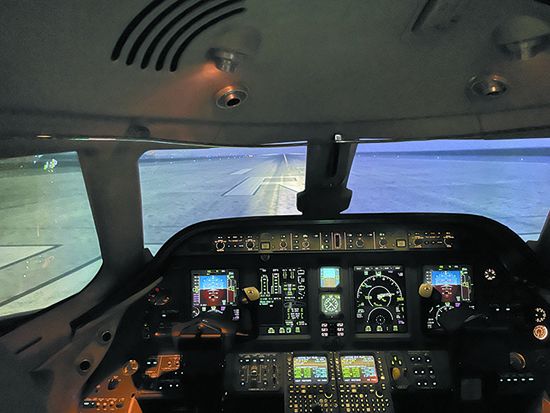Earlier this year the pilot shortage reached my lowly position as a retired geezer with a jet type rating but who hadn’t flown jets regularly for over 40 years. I accepted a job offer to fly copilot in a Cessna Citation Sovereign Plus. That meant I needed a second-in-command type rating. The company’s insurer required that I complete simulator-based training. I fervently agreed with the requirement—I’d been through such training before.
I was scheduled into CAE’s (www.cae.com—one of the big dogs in simulator training) facility in Morristown, New Jersey. I would undergo all of the classroom and procedures training for the PIC type rating, but have three, rather than seven, full motion, Level D simulator sessions. I would not take a checkride but would have to demonstrate performance of all of the tasks set out in CAE’s FAA-approved training program to ATP standards.
Once enrolled, I received an electronic dump of more than 2000 pages of training materials and manuals. There was no guidance as to where to start. That was the one shortcoming, in my opinion, of the course.
Training was the figurative drinking from the firehose. There were five of us in class, with varying levels of experience, including one with no jet time at all. Bottom line, CAE was ready for all of us and, while we each worked our whatsis off, the training was carefully geared to get each of us up to the proficiency required to obtain a type rating.
Classroom time was primarily learning systems—in detail—and was we’ll organized, with quizzes that took one deeply into the material. The bad news was that there was a LOT of material. My lips are still tired from all that reading. Instructors were, by and large, good. Visual aids in class were almost always great, except when a computer would glitch. Then it was hard, time-consuming homework after eight hours of class.
The high point of the whole thing was the incredible level of support among my classmates for each other. We bonded, actively worked together and encouraged each other.
After several days of class we were introduced to a computerized procedures trainer that showed the cockpit in full size with touchscreens so that we could learn the switchology needed for startup, programing the Honeywell automation and systems operation. It was a good learning tool but would have been much better if all of the displays had worked reliably.
The school started out with morning class at 9 a.m., ending up at 5 p.m., with short breaks and an hour for lunch in a wonderful small cafeteria.
Hours got earlier; classes started at 8, then 7. When it came sim time for me, briefing was at 6:30 am. I teamed with the young man with no jet time—who turned out to be an incredibly good sim partner. Not surprisingly, our first day in the sim was ugly. Programming took a long time. Most of the flying was on autopilot as the emphasis was on making the automation do what we wanted. There were about 20 minutes of hand flying and neither of us did well. I came out of the first day wondering if there was any hope at all.
My sim partner and I then spent two hours in the procedures trainer practicing things where we felt weak. At this point we’re 10 days into the program and I’m running on four hours of sleep a night.
Day two in the sim brought drastic improvement. I was able to fly the steep turns to ATP ACS standards the first try. The stall series went just fine and hand flying the instrument approaches, even single engine, wasn’t bad. My night circle-to-land approach at JFK fell apart completely because I turned base too close. However, I came out of the sim that day convinced that I could fly it and that I’d get through the last day—lots of single-engine work—OK. My sim partner did a great deal better, although his standards for himself were so high that he wasn’t feeling very good.
Day three was engine outs, including V1 cuts. In a jet you hit a speed before takeoff speed where you are going to continue the takeoff come hell or high water—it’s called V1. At that point the pilot takes her right hand off the power levers and puts it on the control yoke. You’re going.
Of course, that’s when the instructor cuts an engine and the jet heads for the weeds. It takes full rudder— right now—to handle things. If you do that, it’s not a terribly big deal; you then hold the rudder, raise the nose and take off to deal with the problem in the air. (The photo above is of the sim set up for takeoff malfunctions on Runway 13R at JFK.) I hadn’t done a V1 cut in years. I figured that I could do it, but I’d need a few tries. To my amazement, I nailed it right out of the box and the instructor went on to other things. The circle-to-land approach went fine this time, as did the rest of the emergencies and fires and blown tires and passengers demanding more vodka in the middle of an approach to minimums. My sim partner also had a very good day.
We came out of the box to see two of our classmates about to go in. They saw our expressions and started congratulating us. I’d passed—and, several days later, all of my classmates passed their checkrides.
I may, by gawd, be a geezer, but I can still learn. And oh lordy, lordy, I do love flying jets. —Rick Durden





